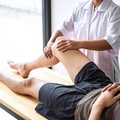
Squats are easily one of our favourite exercises at Holland Landing Health Centre! They are a great full-body exercise that incorporates your gluteus, thigh and calf musculature, as well as core, upper limb and back musculature! Below find 3 of the reasons we love to prescribe squats to our patients!
- Squats are an extremely effective exercise for athletes looking to improve their sport specific performance. The squat utilizes and coordinates a number of different muscle groups, and by strengthening these muscle groups athletes are able to enhance powerful athletic movements such as running, lifting and jumping!
- Squats help improve functional activities and overall quality of life by strengthening muscles and mimicking movements that we use in our day-to-day life. Activities such as walking, sitting to standing and bending are all strengthened with good squat program.
- Squats are also a relatively safe, close-chained exercise that is great for rehabilitation of the lower limb, as well as a good indicator for biomechanical deficiencies. Due to the large number of muscle groups involved, improper technique can signal to a practitioner that certain muscles or joints are not working properly (i.e. reduced dorsiflexion of the ankle or weak core musculature). This provides valuable information that will help enhance your individualized treatment plan to iron out any deficits that may be perpetuating your injuries!
When it comes to performing squats it’s important to ensure that you are able to properly perform a body-weight squat BEFORE adding weight. How do you perform a basic squat?
- Begin with your feet flat on the floor; approximately shoulder width apart with your hips and knees extended in a neutral position.
- Create intra-abdominal pressure by inhaling about 80% of maximal inhalation and hold. This will help “prepare the spine to bear compressive load” and creates “proximal stiffness that enables more power development in the shoulders and hips”
- Descend down until your thighs are at least parallel to the ground, and the hip joint is at least level or slightly below the knee joint.
- Slowly ascend until you reach your starting point!
Dr. Kyla Nelson is currently a chiropractor and acupuncture provider at Holland Landing Health Centre in East Gwillimbury, Ontario, which services Holland Landing, Newmarket, Aurora, Keswick and Bradford areas. If you are interested in chiropractic or acupuncture services please contact Holland Landing Health Centre at 905-853-7900 or via e-mail at info@HLHC.ca
References
Myer, Gregory D., et al. “The back squat: A proposed assessment of functional deficits and technical factors that limit performance.” Strength and conditioning journal 36.6 (2014): 4.

Admin
Contact Me



